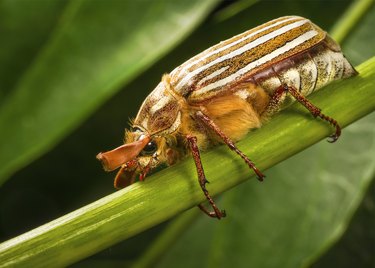
There are several species of beetles known generically as June bugs, including the ten-lined June bug (Polyphylla decemlineata). These haphazard fliers frequently run into people, but they're harmless to humans. They'll destroy your plants, however, and they can make a big mess out of your lawn or garden. Controlling them is possible but difficult once they've taken hold, in large part because of their two- to four-year life cycle.
Identification and Life Cycle
Video of the Day
Ten-lined June bugs begin their life in the soil. Females lay their eggs deep in the soil, and they hatch in about four to six weeks. At this time, you may start to see the young larvae, called grubs, if you're working in the garden. This typically occurs in May and June. At this stage, a June bug looks like a white letter "C" with a red or brown head. They can be about 2 inches long.
Video of the Day
The grubs stay in the soil as they grow, feeding on the roots of plants and grass as they mature. If they don't get enough to eat, the grubs simply dig deeper into the soil for the winter where they won't freeze and begin their eating cycle anew in the spring. They can repeat this process for two to four years if necessary.
When they emerge from the soil as adults, ten-lined June bugs are about 3/4 to 1 1/2 inches long and feature 10 white stripes on their backs, running from the brown head to the thorax. You will see adults from June or July into early fall. As winter approaches, the adults will die, and the larvae will move deeper into the soil for protection.
Assessing the Damage
Ten-lined June bugs can damage your lawn and garden in two ways. During the larval stage, grubs eat plant roots below the soil's surface. This often causes large brown patches of dead grass in lawns and can severely stunt plant growth in the garden. Grubs also feed on tree roots, so young trees may die before they can establish a healthy root system.
Adult June bugs cause their damage on the surface. They feed on leaves and are frequently found chewing holes in roses, strawberries, apple trees, almond trees, and potatoes. You will likely see the insects on these plants and others. Even if you fail to catch them in the act, you'll definitely notice the unsightly holes they leave in your plants' leaves.
Getting Rid of Ten-Lined June Beetles
If you're seeing ten-lined June bugs in your garden, there are many steps you can take to eliminate them. The simplest way is to pick them off your plants by hand. They can't hurt you, and killing them is as simple as dropping them into a cup of soapy water.
You can also make homemade traps to help solve your beetle problem. To do so, cut the top off a 2-liter soda bottle. Place the top back on the bottle upside down so that it looks like a funnel. Dump some molasses or fruit juice in the bottom of the trap and then bury it next to infested plants. Keep only the funnel part of the trap above the soil. If you leave the trap out overnight, you'll have lots of trapped beetles to dispose of in the morning.
If you find grubs while working the top few inches of your soil, you can get rid of them naturally by tilling the area. Doing so exposes the grubs and makes them easy prey for birds and other animals looking for a tasty treat. If your problem area is too large to till practically, treat your lawn with Bacillus thuringiensis (Bt). Available at most hardware stores and garden centers, Bt is a natural bacteria that kills grubs but is safe for people and pets.
Unfortunately, bad infestations may require the use of potent pesticides that are best applied by a professional exterminator. Once your grubs are gone, discourage them from coming back by keeping your yard and garden very well irrigated in June. Ten-lined June bugs are less likely to lay their eggs in damp soil than in dry soil. You may never be able to rid yourself of these ubiquitous pests completely, but you can reduce their numbers.